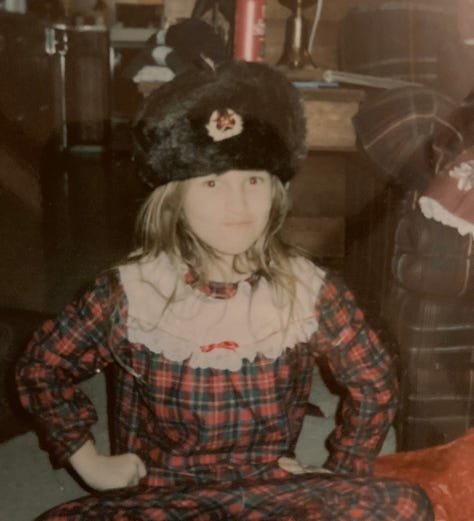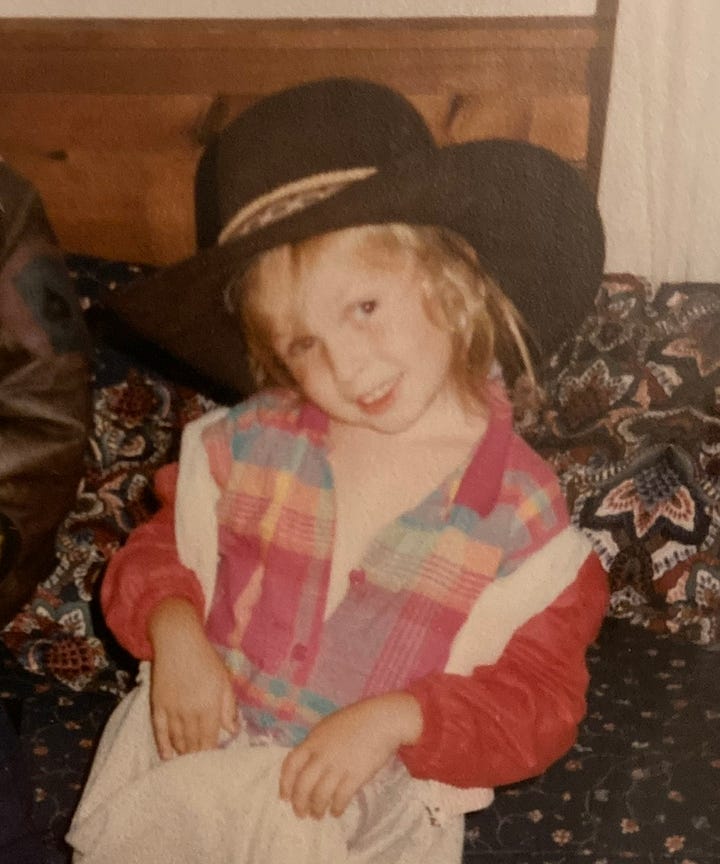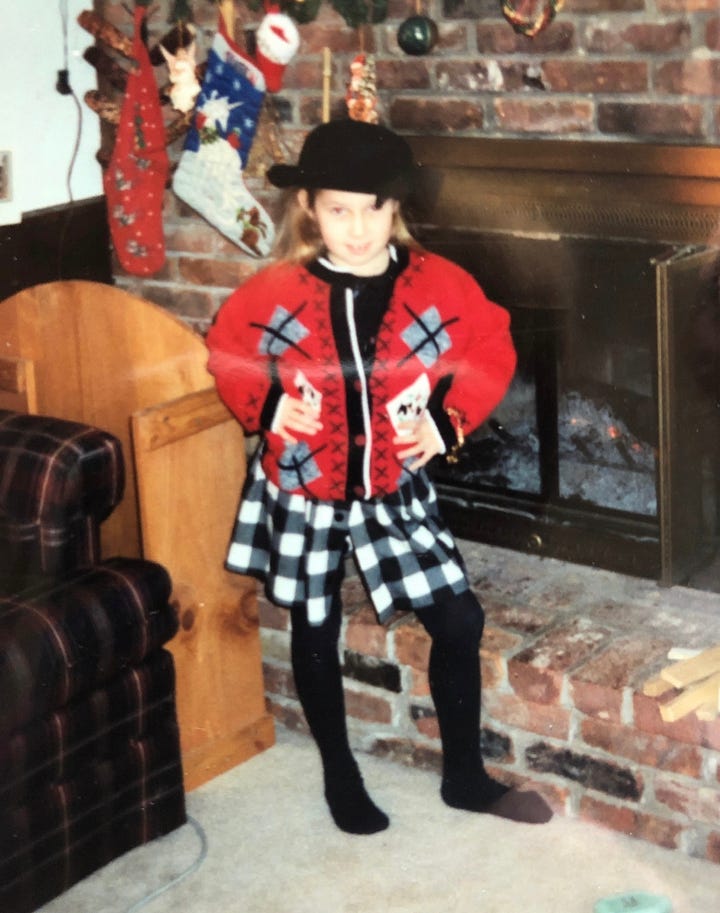Hey! A little about this piece before we get started: this is a two-parter.
First, I dive into the history of my own fashion as I think it will lend some color to why I care so much about local fashion. Clothes are such an important part of culture in general, and doing a little dive into my relationship with them seemed like a fair place to start.
Then next week, I want to discuss fashion in this region — how locals identify one another, what tropes tourists always seem to do, how seasons and sports can dictate fashion more than personal style, the history of western wear, and more.
Also, sorry if there are rampant typos in this — my right thumb is temporarily out of commission due to tearing the ligament between my thumb and index finger. Turns out, typing in a brace is a challenge! So this should be fun for all of us.
In the first grade, I was the proud owner of an exceptional hat collection — exceptional not in its quality, but in its “except Kelton” power. I wore hats to school when no one else was allowed. Mrs. Shook just couldn’t resist my collection of bowler hats, berets, western caps, and the like; so while the rest of my class abided by the rules, I experienced the warm, corruptive glow of favoritism.





It would only be 2-3 or three more years until I started asking my mom for fashion forward magazines. I started with the usual 1990s suspects: YM, Seventeen, the dELiA*s catalog, before I eventually graduated to Vogue, Elle, Harper’s Bazaar, and more. I loved fashion. I loved the way clothes could make you disappear and then reappear as a totally different person. I loved the messages implied when wearing combat boots versus jellies, platform heels versus boat shoes. You could rewrite your entire narrative with a single outfit, and I often did. When I lost Best Dressed to a girl who looked like she could only shop at stores that started with ‘A’ (Abercrombie, American Eagle, Aeropostale), I knew my art was lost on my classmates. (Nevermind that my fashion was abhorrently bad.)
In my senior year English class, we were tasked with doing a reported, investigative feature. Since the very limited things on my mind were fashion, cars, boys, and leaving, I went with fashion. Since Mrs. Shook had deemed me excused from the rules in the first grade, I had become the golden child of fashion exemptions. Because I was your standard must-achieve-at-everything obsessive, teachers just didn’t care what I did. They didn’t care when I was late, they didn’t care when I talked out of turn, and they really didn’t care what I wore.
My high school had your typical dress code of the 90s and 00s. For the girls, no short skirts, no spaghetti straps, no bra straps showing, no underwear peeking out, no midriffs, no heels, etc. For the guys, no baseball caps, no gang affiliated wear, no baggy jeans, no shoes that scuffed the floor, and again, no underwear peeking out. Punishments for violating the dress code were common: everything from having to change into something from the Lost & Found, to being sent home, to being sent to detention. But not me. Not the straight-A treasurer of student council heading off to track practice before going to rehearsal. No one ever said a word — until I did.
Every day for the month of the project, I broke more and more dress code rules. I piled them onto one another until I looked like a modern day Shein hauler. At the same time, I was working with one of the administrators in the principal’s office to get an accurate count of what punishments were being doled out for dress code violations, and working with my classmates to determine who was getting the punishment. I told the principal that the project was advocating for uniforms to promote a better learning environment. I even interviewed the Vice Principal about the dress code.
“I’m actually wearing spaghetti straps right now, but haven’t received any requests to change. Why do you think that is?” I asked him, full of teen angst and Tracy Flick.
“The dress code isn’t really for kids like you.”
When I presented the project, it was centered on the discriminatory practices of the dress code and how it was used to punish lower income and lower achieving students. The Vice Principal sat in for all our reports, and I quoted him to his face. Looking back, it’s a miracle I wasn’t suspended. But it was obvious to the students and it needed to become obvious to the school administration: only the kids with bad grades or from '“bad families” were punished for breaking the rules.
I understood then that fashion could be used against you. We use it against each other all the time.
Fashion would stay with me for years. My first week of college, I called my best friend in tears, absolutely flummoxed to see every single person wearing the exact same outfit. The girls were in Seven jeans, Patagonia fleeces, and Rainbows, while the guys were in khaki shorts, polos, and boat shoes. For the brief moment when I’d considered rushing a sorority, I was given a pamphlet that outlined which designer I would be expected to wear to each of the different rush events. I’d stepped into the nightmare that is the wealthy South, and it was only resolved when, at a party, a guy in a basketball jersey and Jordans and a baseball cap came up to me and said, “Hi, you’re from out of state, I see.” I asked how he knew, and he said, “Look at what you’re wearing.” High-heeled fuchsia combat boots. He and I are still friends.
In my 20s, fashion was how I experimented with my identity. An ex of mine once told me it looked like I tried on a new personality every day.

He wasn’t wrong. I was dressing to find out who I was, and more importantly, to see how people treated these different personalities. Who could get away with more? Who attracted more fun? Who did people fear? All of these photos were taken while I was working at an ad agency. My work was entirely focused on how you presented a product. I was trying to find my brand. At the holiday agency party, we voted on superlatives for each other. This time, I did win Best Dressed. I wasn’t even the most stylish, just the most focused on finding their style. The ad agency was in the granola-filled, technical apparel-wearing, Subaru capital of the world: Boulder, Colorado — and I still managed to dress like I’d bought an outfit at every single store in the mall.
When I moved to Santa Monica, I continued to shape shift. I was sporty, then tropical, then preppy, bouncing through the lexicon of fashion with nary a care — until the cares caught up with me. It’s embarrassing to say it took me that long to understand the damage fast fashion was doing, but I got there eventually. Articles like this shifted my entire perspective. It was time to narrow the heap, and keep it narrow. I moved to Topanga and spent the next six years without a closet. If you ever want to be shamed out of half your wardrobe, I highly suggest pretending you don’t have a closet either. (Though being confronted with your own abundance does not seem to have the same effect on everyone.) As my clothes whittled down, what I kept revealed my own style better than shopping ever had: earthy colors, somewhat sporty, somewhat Western.
In LA, you could dress however you wanted. You could be in head to toe linen, or all designer, or up-cycled chic, or goth resurgence, whatever called to you was calling to someone else in that city too. But there was limited cross-pollination — the all linen look was almost always the beach with a big hat and a big bag, the designer labels sticking Beverly Hills and parts of Hollywood, and everything with a bit of grunge was East Side. Living in Topanga without question influenced my style. I was in the mountains (however small) and I started to dress like it. I also, finally, started to feel like myself in my clothes.
Dress for the job you want, but really, dress for the life you want. As my style focused, so too did my Zillow search: we were going back to Colorado.
One of the more magical (and sometimes deeply frustrating) parts of LA is the weather. You can wear whatever you want nearly every day of the year. Short shorts with high tops and a sports bra and a puffy? Sure. Crop top with a floor-length skirt and a wide-brimmed hat? Yeah, fine. Oversized sweater with jeans and sandals? Maybe not in the summer on the East Side, but definitely any day in the marine layer. But while nights could accommodate most jackets, most days were just warm. They were sunny, festive, and really, really warm. I had so many little dresses! Every day was a little dress day! Do you know what day is not a little dress day?
Almost every single day where I live now. And so, the wardrobe shrunk again. The little dresses were handed out amongst friends or donated, and a precious few were relegated to a small bag of “vacation clothes.” Now, the wardrobe looks like this almost all year:
It’s a lot of jeans, sweaters, three colors of long since discontinued Lululemon joggers, turtlenecks, and of course, athletic wear. But there is one element of my style that isn’t as welcome here. One element that stands out. One element that I loved my whole life that slinks around the back of my closet pouting about when it gets to come out: glamour.
From the very beginning of my fashion journey, the one through-line, the one thing that I always, always loved was glamour. I loved a smashing dress and a great red lip. I loved a very high heel and a very high pony. I loved to curl my hair and wing my eyes and put on a dress that twirled and spun. Opportunities for that to feel appropriate became more and more rare as I embraced a quieter lifestyle, but here? It’s not that those opportunities are rare — it’s that they send a message, and it’s not always the one you want. At the intersection of adventure sport, wealth, access, and housing, what you wear becomes who are. And if what you wear is glamorous?
You might be drawing a line in the snow.
Next week: mountain town fashion, the history of westernwear, big hats in a small town, and what your leggings say about your life.





I love this--I was obsessed with fashion mags as a tween and teen but was too afraid to experiment with my style in school (guess what little introvert did it in her room, took pics with disposable cameras, and then changed into something more boring?) and tbh I’m only now just starting to understand MY style as opposed to what I THINK I should wear. And it’s a lot more masc, looser, western, earth tones... comfy desert meesh, I guess.
I love fashion too! My story is different. I was actually from one of those low income families so I couldn't afford to wear anything fashionable. I remember this time I had to wear torn shoes coz my family couldn't afford to replace them.
So when I started to make my own money I started to shop! And how! Now after a baby my closet is full of the latest season which doesn't fit. I may have to throw 'em all out unless I lose the love handles.